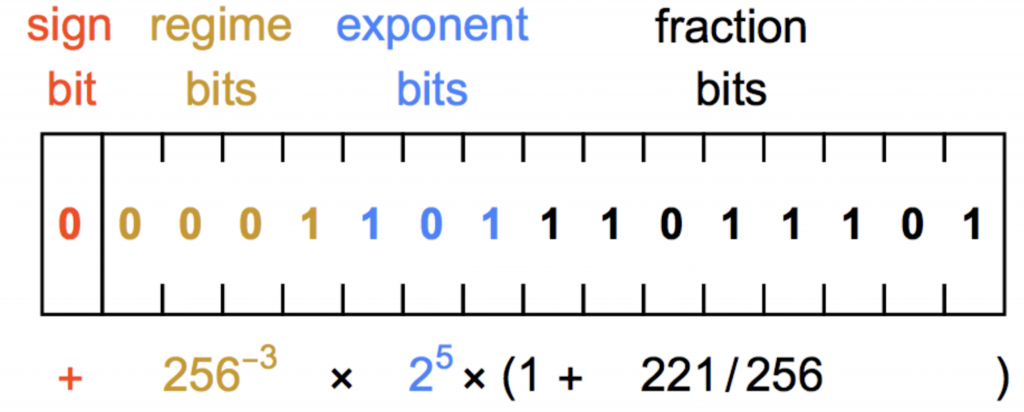[Glean] Posit: A Potential Replacement for IEEE 754
Posit: A Potential Replacement for IEEE 7541
Introduction
In February 2017, Gustafson officially introduced Unum type III, posits and valids. Similar size posits when compared to floats offer a bigger dynamic range and more fraction bits for accuracy. Posits have variable-sized index and mantissa bitfields, with the split being specified by a "regime" indicator.2
Four parts
Posits consist of four parts: sign, regime, exponent, and fraction (a.k.a. significand/mantissa). For a $n$-bit posit, regime can be of length 2 to $(n − 1)$. The format of the regime is such that it is a repetition of a same-sign bit and terminated by a different-sign bit. 2
The sign bit is 0 for positive numbers and 1 for negative ones. The number of regime bits is dynamic following a special encoding. After the sign bit, the regime includes a run of 0 or 1, which is terminated by an opposite bit ($r̄$) or at the end of the number format. Similarly, the number of bits for the exponent and fraction is dynamic. A posit number includes the exponent and fraction only if necessary.1

Let $m$ be the number of identical bits in the regime bits (amber color). If the first bit is zero, the number of zeros ($m$) represents a negative value ($-m$). Otherwise, the number of ones minus one ($m-1$) represents a positive value $(m-1)$. The regime bits realize a scale factor of useedk, where $useed = 2^{2^{es}}$.1

As for the exponents bits, I think it's predefined.
The recommended posit sizes and corresponding exponent bits and quire sizes:2
| Posit size (bits) | Number of exponent bits | Quire size (bits) |
|---|---|---|
| 8 | 0 | 32 |
| 16 | 1 | 128 |
| 32 | 2 | 512 |
| 64 | 3 | 2048 |
Note: 32-bit posit is expected to be sufficient to solve almost all classes of applications.
-
P. Behnam, M. N. B. on Apr 21, and 2020, “Posit: A Potential Replacement for IEEE 754,” SIGARCH, Apr. 21, 2020. https://www.sigarch.org/posit-a-potential-replacement-for-ieee-754/ (accessed Jan. 18, 2021). ↩ ↩2 ↩3
-
“Unum (number format),” Wikipedia. Dec. 29, 2020, Accessed: Jan. 18, 2021. [Online]. Available: https://en.wikipedia.org/w/index.php?title=Unum_(number_format)&oldid=996875965. ↩ ↩2 ↩3